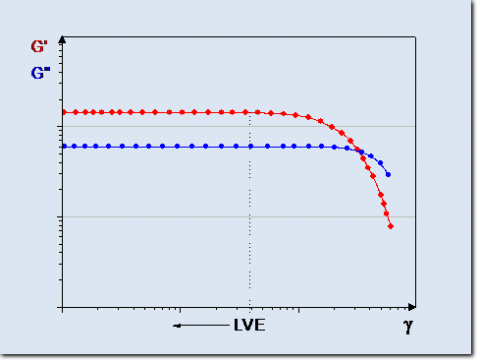Oscillatory tests

Amplitude sweep
During an amplitude sweep the amplitude of the deformation - or alternatively the amplitude of the shear stress - is varied while the frequency is kept constant. The amplitude is the maximum of the oscillatory motion. For the analysis the Storage modulus G' and the Loss modulus G'' are plotted against the deformation.

At the amplitude sweep the moduli G' and G'' are plotted against the deformation. The moduli in the linear-viscoelastic region at low deformation characterize the structure in peace of the sample
At low deformationen G' and G'' are constant; the sample structure is undisturbed. This region is called linear-viscoelastic (LVE). As soon as the moduli start to decrease, the structure is disturbed, till the end of the LVE-reagion is reached: the plateau value of G' in the LVE-region describes the rigidity of the sample at rest; the plateau value G'' is a measure for the viscosity of the unsheared sample. The ratio of the two moduli gives information about the characteristic of the sample: If the storage modulus is larger than the loss modulus - like shown in figure 1- the sample behaves more like a viscoelastic solid. In the opposite case - G'' > G' in the LVE-region - the sample has the properties of a viscoelastic fluid.
As larger the difference between the moduli are as more the samples show the properties of a pure fluid and solid, respectively.
With the amplitude sweep also the yield point can be determined. Therefore two special points can be used: the end of the LVE-region and the intersection of the curves for G' und G''. In most cases the intersection of G' und G'' is of more practical importance.
